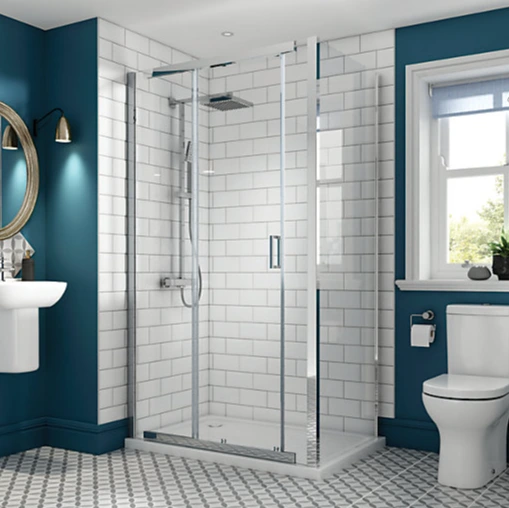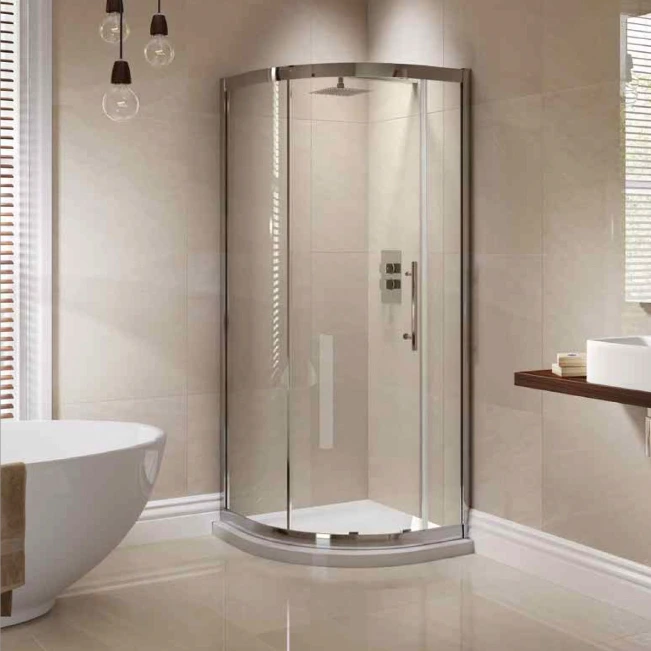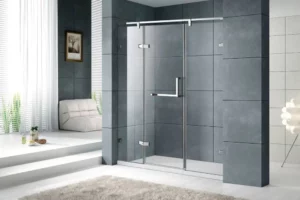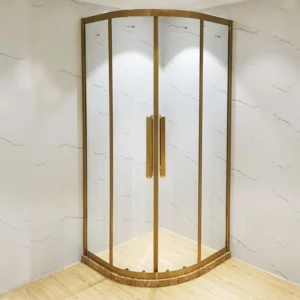Purchasing a large quantity of Shower Enclosures for Bathroom Superstore with diverse styles and high-quality materials is vital to the success of your bathroom superstore in the UK. This in-depth procurement plan delves into shower enclosures’ styles, materials, production processes, transportation, packaging, purchasing, and supplier recommendations.
Crown has its own manufacturing plant, which strictly controls the production process and guarantees quality. Since its establishment in 2004, it has had 18 years of reception experience, treats customers sincerely, can accurately judge your needs and make modifications and adjustments according to your needs. Crown has a professional sales team and professional engineers to solve the problem for you Confused, but also to provide you with a more professional and efficient service.
Crown is also the home of two manufacturing plants which employ environmentally-friendly manufacturing methods. Additionally, Crown is a family-owned firm that is constantly developing innovative products and improvements in hygiene that are a reflection of the vision shared by the entire family. Our manufacturing experience of longer than 18 years will enable us to respond quickly to your demands and provide the most efficient solution.
Crown is a collection of employees that are easily available. The establishment of groups that contain sales and engineers will help ensure the effectiveness of your business’s strategies. That means that you don’t need to worry about the design of your business or the structure of your company. Crown can provide you with an online-based packaging design which will enable you to expand your business on the internet.

a.Quadrant: Space-saving design with curved edges, suitable for small bathrooms.
b.Pivot: Features a door that swings outward on a pivot hinge, ideal for mid-sized to large bathrooms.
c.Sliding: Uses sliding doors, making it a great option for compact bathrooms.
d.Hinged: Contains a door that opens outward on hinges, appropriate for larger bathrooms.
e.Walk-in: A spacious, open design without a door, perfect for larger and accessible bathrooms.
f. Frameless: A modern and sleek design with minimal hardware, suitable for contemporary bathrooms.
i.Glass: Tempered glass is the most popular choice due to its durability and elegant appearance. It can be clear, frosted, or patterned.
ii.Acrylic: Lightweight, cost-effective, and easy to clean, acrylic is an excellent alternative to glass.
iii. Frames: Aluminum or stainless steel frames are commonly used for their durability and corrosion resistance.
Budget
The budget for Shower Enclosures for Bathroom Superstore depends on styles, materials, and quantities. Wholesale prices typically range from £100 to £1,500 per unit. Allocate a budget based on your target customer segment, desired product range, and the styles and materials you wish to offer.
The shower enclosure production process generally involves:
a. Design and engineering: Creating technical drawings and specifications for each style.
b. Frame fabrication: Cutting and assembling aluminum or stainless steel frames.
c. Glass or acrylic cutting: Cutting panels to size and polishing the edges.
d. Glass tempering: Heating and cooling glass panels to enhance their strength (if applicable).
e. Assembly and quality control: Assembling components, ensuring proper alignment and functionality, and conducting inspections.
f. Packaging: Securing finished products in protective packaging for transportation.

Shower Enclosures for Bathroom Superstore require careful packaging to protect fragile components during transit. Packaging options include:
a. Wooden crates: Sturdy crates that provide excellent protection, particularly for glass panels.
b. Cardboard boxes: Reinforced boxes with foam inserts to cushion the components and prevent damage.
c. Pallets: Loading crates or boxes onto pallets for secure transportation.
Coordinate with your chosen supplier to facilitate transportation, either through their shipping services or third-party logistics providers.
Select a shower enclosure manufacturer or wholesaler based on:
a. Product quality and variety: Ensure the supplier offers a diverse range of styles and materials that cater to your customers’ preferences.
b. Manufacturing capacity: Confirm the supplier’s ability to meet your quantity requirements and production timelines.
c. Shipping and lead times: Opt for suppliers with reasonable shipping times and reliable delivery schedules.
d. Compliance with UK safety standards: Ensure products meet UK safety regulations and standards, such as CE marking and BS EN 14428.
e. Pricing and payment terms: Negotiate competitive pricing and favorable payment terms.
f. Customer service and support: Choose suppliers with excellent communication and prompt issue resolution.
Follow these steps to procure shower enclosures:
a. Research potential suppliers through online platforms (e.g., Alibaba, Made-in-China), industry directories, and trade shows.
b. Request product catalogs, price lists , and samples from potential suppliers to evaluate product quality, variety, and pricing.
c. Evaluate suppliers based on the selection criteria mentioned above, such as manufacturing capacity, shipping and lead times, compliance with UK safety standards, pricing, and customer service.
d. Shortlist the top suppliers and schedule meetings or site visits to further assess their capabilities, if feasible.
e. Negotiate pricing, payment terms, and delivery schedules with your chosen supplier(s), ensuring that you reach a mutually beneficial agreement.
f. Place a purchase order, specifying the styles, materials, and quantities required, along with any customization requests or additional requirements.
g. Arrange for transportation and logistics, either through your supplier’s shipping services or by partnering with a reliable third-party logistics provider.
h. Track the shipment’s progress and communicate regularly with the supplier to ensure timely delivery.
i. Inspect the delivered products for quality and compliance with the purchase order. Address any issues or discrepancies with the supplier promptly.
j. Integrate the new shower enclosures into your store’s inventory and display them in your showroom, highlighting their unique features and benefits to attract customers.
Bathroom superstores, given their expansive offerings, provide a myriad of advantages for those on the hunt for the perfect shower enclosure. Here’s why they come highly recommended:
Shower stalls available in bathroom superstores, often termed as “shop shower stalls”, exhibit designs that tend to be more contemporary, innovative, and user-friendly compared to traditional ones. Here’s a comparative overview:
Walk-in shower enclosures have gained immense popularity for their luxurious look and feel. When it comes to materials, there’s a range to choose from, each offering unique benefits:
Tempered Glass: A prevalent choice, tempered glass is heat-treated for strength, ensuring it breaks into small, harmless pieces if shattered.
Acrylic: Lightweight and durable, acrylic panels are resistant to scratching and retain heat well, ensuring a warm touch.
Fiberglass: An economical choice, fiberglass is lightweight and comes in various finishes, mimicking materials like tile or stone.
Tile: Traditional yet versatile, tiles offer a wide range of design possibilities, from ceramic to porcelain to natural stone.
Stone Resin: This material provides a natural stone look without the weight or price tag, offering durability and a modern aesthetic.
Cultured Marble: A blend of marble dust and resin, it offers the luxurious look of marble without its porosity or price.
Corian: This solid surface material can be molded into various shapes, is easy to clean, and is available in a wide range of colors.
Stainless Steel: Especially prevalent in industrial or contemporary designs, stainless steel is durable, modern, and resistant to corrosion.
Laminated Glass: Consisting of two glass sheets with an interlayer, it’s tough and holds together when shattered.
Polystyrene: An affordable option, polystyrene panels are waterproof and come in various designs, but they may lack the durability of other materials.
Selecting the appropriate size for a shower door is crucial for both functionality and aesthetics. Here’s a step-by-step guide:
Measure the Opening Width: Using a measuring tape, measure the width at the top, middle, and bottom of the opening. Use the widest measurement.
Measure the Height: Measure from the base to the top of the wall or tile. If there’s a slope, measure both sides and use the taller measurement.
Consider the Swing: Ensure there’s enough space for the door to swing open without hitting any obstacles, like toilets or vanities.
Factor in Overlaps: For sliding doors, you’ll want an overlap of about 2-4 inches to prevent water spray from escaping.
Frame or Frameless: Frameless doors need precise measurements as they lack the adjustment flexibility that framed doors offer.
Hardware Considerations: The thickness of your door can determine the type of hinges or rollers you’ll need.
Ventilation: Ensure there’s enough space above the door or along the sides for proper ventilation, especially if you have a steam shower.
Safety Clearance: Ensure there’s a minimum clearance between the fully opened door and adjacent fixtures to prevent glass breakage.
Seek Expertise: When in doubt, consult with professionals at bathroom superstores, who can guide you based on your bathroom layout.
Always Double Check: Before making a purchase, always double-check your measurements to avoid costly mistakes.
Regular maintenance of your shower enclosure ensures its longevity and keeps it looking pristine. Depending on the material, here’s what you should consider:
Tempered Glass: Use a squeegee after each use to prevent water spots. Clean with a mixture of white vinegar and water to avoid streaks.
Acrylic & Fiberglass: Avoid abrasive cleaners. Instead, use mild detergent or baking soda with water. A soft cloth is ideal.
Tile: Clean grout lines periodically to prevent mold. Use a mildew-resistant sealant for best results.
Stone Resin & Cultured Marble: Avoid acidic or abrasive cleaners. A non-abrasive detergent with warm water works best.
Corian: For everyday cleaning, warm soapy water or an ammonia-based cleaner is ideal. Avoid window cleaners.
Stainless Steel: Use a mild detergent with water and always wipe in the direction of the steel grain. Avoid chlorine-based cleaners.
Laminated & Polystyrene: A soft cloth with warm soapy water is best. Always rinse and dry to avoid water spots.
Seals & Hardware: Clean rubber seals with soapy water to prevent mold. Wipe metal hardware with a damp cloth and occasionally check for tightness.
Ventilation: Ensure proper ventilation to prevent mold and mildew. Open a window or use an exhaust fan.
Regular Checks: Periodically check for leaks, loose fixtures, or signs of wear. Address issues promptly to prolong the enclosure’s life.
Distinguishing between framed and frameless shower doors can greatly impact the overall aesthetics and functionality of your bathroom. Here’s a detailed comparison:
Appearance:
Installation:
Cost:
Durability:
Maintenance:
Customization:
Aesthetics:
Glass Thickness:
Replacement:
Water Sealing:
When investing in a shower enclosure, the brand or manufacturer plays a pivotal role in ensuring quality, durability, and style. Here are some renowned brands:
Kohler: Known for its innovative designs and high-quality materials, Kohler stands out in both aesthetics and functionality.
American Standard: With a history spanning over 140 years, they offer reliable and stylish bathroom solutions.
DreamLine: Specializing in shower doors and enclosures, DreamLine boasts a wide range of modern designs.
Moen: Beyond faucets, Moen’s shower enclosures are revered for their durability and sleek designs.
Delta: A household name, Delta offers a wide variety of designs catering to different tastes and budgets.
VIGO: Prioritizing craftsmanship and design, VIGO’s shower enclosures are both functional and artful.
MAAX: With a focus on luxury and relaxation, MAAX’s enclosures are both stylish and comfortable.
Ove Decors: Blending quality with innovative designs, Ove Decors offers a unique range of shower solutions.
Aston: Known for their frameless shower enclosures, Aston brings luxury to the forefront of bathroom design.
Basco: With a rich history and a commitment to excellence, Basco’s products are built to last.
Customizing a shower enclosure can uplift the entire aesthetic of your bathroom. Here’s a guide to achieve a cohesive look:
Choose a Complementary Style: Whether your bathroom is modern, traditional, or eclectic, select an enclosure that aligns with its style.
Material Selection: Based on your bathroom’s theme, choose materials that enhance its appearance, be it glass, acrylic, or tiled.
Frame Decision: Decide between framed, semi-frameless, or frameless. Each offers a distinct look.
Hardware Finish: Select hardware (like handles and hinges) in finishes that match or complement other fixtures in your bathroom.
Glass Texture: Beyond clear glass, consider frosted, rain, or tinted glass for added style and privacy.
Functional Additions: Incorporate features like benches, shelves, or steam outlets to enhance the shower experience and aesthetics.
Incorporate Lighting: LED lights or strategically placed fixtures can accentuate the shower’s design.
Door Mechanism: Choose between hinged, pivoted, sliding, or bi-fold doors based on your space and preference.
Incorporate Art: Consider etched glass designs or unique tiles to add artistic flair.
Consult a Designer: If unsure, consult with an interior designer who can guide based on your bathroom’s layout and style.
Safety is paramount when dealing with shower enclosures, especially given the use of glass and slippery conditions. Here are vital safety considerations:
Use Tempered Glass: This safety glass is designed to shatter into small, non-sharp pieces if broken, reducing the risk of injury.
Secure Installation: Ensure that all fixtures, brackets, and supports are securely fastened to prevent any movement or dislodging.
Waterproof Seals: Ensure that seals are intact and effective in preventing water leaks, which could lead to slippery floors outside the enclosure.
Regular Inspection: Check for any cracks, chips, or damages in the glass or frame. Even minor damage can compromise the structure’s integrity.
Non-slip Flooring: Use non-slip tiles or mats inside the enclosure to prevent slipping during a shower.
Handle with Care: Avoid slamming or applying excessive force to the door, as this could damage the glass or fixtures.
Avoid Sharp Objects: Do not use or bring sharp objects inside the shower, as these can scratch or damage the surfaces, especially glass.
Ventilation: Ensure good ventilation in the shower area to prevent the growth of mold and mildew, which can make surfaces slippery.
Child Safety: If you have children, consider using shower doors with a lock or safety latch to prevent unsupervised access.
Emergency Access: In case of any emergencies, ensure there’s a way to access the shower from outside, such as a door that can be unlocked from the outside.
Maximizing the lifespan of a shower enclosure ensures you get value for your investment and maintain the bathroom’s aesthetic appeal. Here’s how to ensure longevity:
Regular Cleaning: Use appropriate cleaning agents to remove soap scum, water spots, and other residues. This not only maintains appearance but also prevents material degradation.
Soft Water: If possible, use soft water or install a water softener. Hard water can leave mineral deposits on the enclosure, leading to staining and damage.
Avoid Harsh Chemicals: Steer clear of abrasive or acidic cleaners, as these can erode the material, especially seals and metal parts.
Squeegee After Use: Use a squeegee to remove water droplets after each shower. This reduces mineral deposits and the growth of mold or mildew.
Check Seals and Gaskets: Regularly inspect seals, gaskets, and other fixtures. Replace them when they show signs of wear or damage.
Ensure Proper Ventilation: A well-ventilated bathroom reduces the risk of moisture damage and mold growth.
Avoid Overloading: Don’t hang heavy items on the door handles or fixtures. This can strain the glass or door mechanisms.
Protect Glass: Consider using a glass protector or sealant, which forms a barrier against staining and can make cleaning easier.
Regular Inspection: Periodically check for structural issues, such as loosened fixtures, misalignment, or glass damage.
Seek Professional Help: For any significant concerns or damages, consult professionals to ensure repairs are done correctly and safely.

Understanding the various styles, materials, production processes, and logistics involved in shower enclosures will help you make informed decisions when selecting a manufacturer or wholesaler to work with. Following the steps outlined in this in-depth procurement plan, along with keeping the core keywords in mind (Shower Enclosure, Shower Enclosure manufacturer, Shower Enclosure supplier, Shower Enclosure wholesaler, Shower Enclosure wholesale price), will enable you to expand your bathroom superstore’s product range and cater to a diverse clientele while ensuring customer satisfaction and profitability.

Crafting a flawless shower enclosure combines smart planning, durable materials, and precise execution. In 2025,

The African commercial shower market presents unprecedented growth opportunities. Our Shower Enclosure Distributor Network connects

Introduction The African shower enclosure market continues to expand rapidly in 2025. Commercial construction growth
